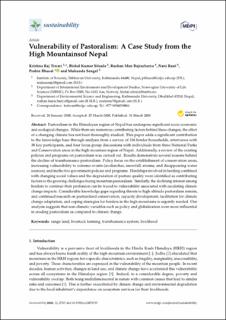| dc.description.abstract | Pastoralism in the Himalayan region of Nepal has undergone significant socio-economic and ecological changes. While there are numerous contributing factors behind these changes, the effect of a changing climate has not been thoroughly studied. This paper adds a significant contribution to the knowledge base through analysis from a survey of 186 herder households, interviews with 38 key participants, and four focus group discussions with individuals from three National Parks and Conservation areas in the high-mountain region of Nepal. Additionally, a review of the existing policies and programs on pastoralism was carried out. Results demonstrate several reasons behind the decline of transhumance pastoralism: Policy focus on the establishment of conservation areas, increasing vulnerability to extreme events (avalanches, snowfall, storms, and disappearing water sources), and ineffective government policies and programs. Hardships involved in herding combined with changing social values and the degradation of pasture quality were identified as contributing factors to the growing challenges facing mountain pastoralism. Similarly, the declining interest among herders to continue their profession can be traced to vulnerability associated with escalating climate change impacts. Considerable knowledge gaps regarding threats to high-altitude pastoralism remain, and continued research on pastureland conservation, capacity development, facilitation for climate change adaptation, and coping strategies for herders in the high mountains is urgently needed. Our analysis suggests that non-climatic variables such as policy and globalization were more influential in eroding pastoralism as compared to climate change. Keywords: range land; livestock farming; transhumance system; livelihood | en_US |

